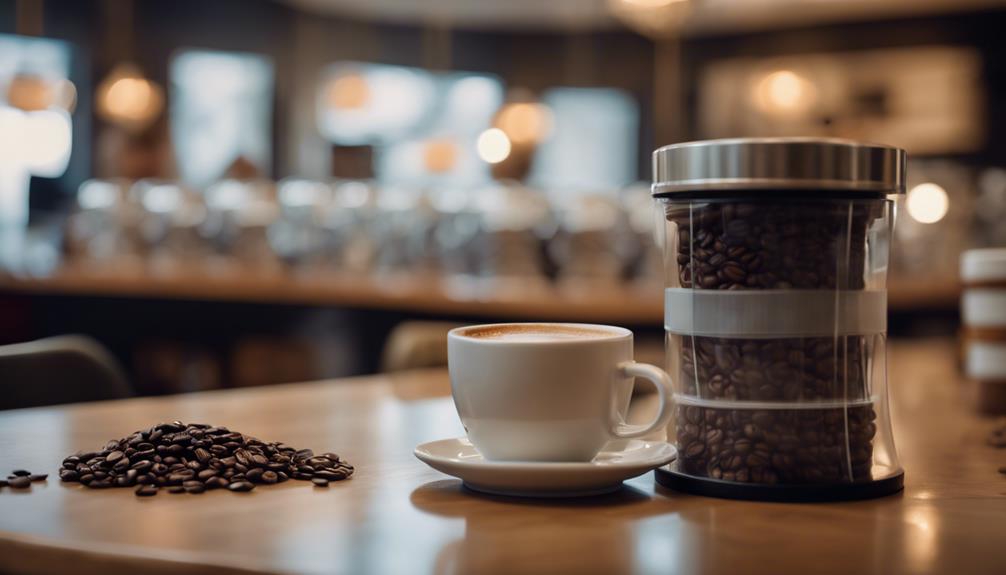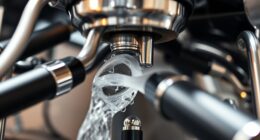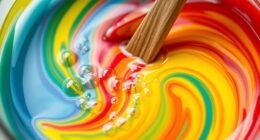When using a retainer, it’s important to be cautious when enjoying coffee to avoid damage and discoloration. To safely drink coffee, consider opting for iced or cold brew to lower acidity and staining potential. Using a straw can help reduce contact between the coffee and retainer, and remember to rinse your retainer after consuming coffee to keep it clean. Dark roast coffee is a better choice as it contains fewer staining agents, and try to limit hot coffee’s contact with the retainer to prevent warping. By following these tips, you can minimize risks and still enjoy your coffee while keeping your retainer safe. As you learn more about caring for both your coffee and retainer, you’ll find more ways to enjoy your favorite brew safely.
Key Takeaways
• Opt for iced or cold brew coffee to reduce acidity and staining potential on your retainer.
• Use a straw when drinking coffee to minimize contact between the liquid and your retainer.
• Rinse your retainer immediately after coffee consumption to remove staining agents and prevent damage.
• Choose a dark roast coffee, which has fewer staining agents, to reduce the risk of discoloration.
• Remove your retainer before drinking coffee or take precautions to minimize contact to prevent staining and damage. It’s important to remove your retainer before drinking coffee because the dark pigments in coffee can easily stain the retainer and cause discoloration. Additionally, the acidity in coffee can also damage the metal or plastic components of the retainer if it comes into contact. To protect your septic system, it’s wise to take precautions such as using a straw to minimize contact between the coffee and your retainer. This will not only help maintain the appearance and functionality of your retainer but also protect your septic system from potential harm.
Coffee and Retainer Compatibility
When you wear a retainer, you need to evaluate how your morning coffee habit might impact its durability and appearance over time. As you enjoy your daily cup, the dark pigmentation and acidity in coffee can lead to stains on your retainer, affecting its appearance and integrity.
Porous retainers like acrylic or ceramic are more prone to coffee staining compared to non-porous materials like metal or wire. The high acidity in coffee can also cause enamel erosion and tooth discoloration when consumed with retainers.
To prevent staining and maintain the appearance of your retainer, proper care is necessary after coffee consumption. Understanding how coffee affects different retainer types is important for choosing the best option based on your lifestyle and preferences.
For instance, porcelain retainers may be more resistant to coffee staining, but it's vital to take into account other factors like enamel erosion and tooth discoloration. By being aware of these factors, you can take steps to protect your retainer and teeth from the negative effects of coffee.
Safe Coffee Consumption Tips

When it comes to safe coffee consumption with a retainer, you'll want to master the basics of coffee handling essentials and cup distance management.
By understanding these critical aspects, you'll be able to enjoy your daily cup of coffee without compromising your retainer's integrity.
Coffee Handling Essentials
By incorporating a few simple habits into your daily coffee routine, you can enjoy your favorite beverage while minimizing the risk of staining or damaging your retainer. As a retainer wearer, it is crucial to be mindful of your coffee consumption to maintain oral hygiene.
Here are some coffee handling essentials to keep in mind:
| Tips for Safe Coffee Consumption | Why it Matters |
|---|---|
| Opt for iced or cold brew coffee | Reduces acidity and staining potential |
| Use a straw when drinking coffee | Protects retainer from discoloration and damage |
| Rinse your retainer after coffee consumption | Removes staining agents and maintains cleanliness |
| Choose dark roast coffee | Contains fewer staining agents |
| Limit contact between hot coffee and retainer | Prevents warping and maintains oral health |
Cup Distance Management
To safely enjoy your coffee, maintain a comfortable distance between your cup and retainer to prevent accidental contact and potential damage. This is essential in cup distance management, as direct contact can lead to the risk of staining or warping your retainer.
When drinking hot coffee, using a straw can help minimize the risk of direct contact and staining. Additionally, be mindful of the temperature of your coffee, as extremely hot temperatures can cause distortion or warping of your retainer material. Practice temperature caution to avoid discomfort or potential harm.
If you're concerned about the safety of your retainer, consider removing it before enjoying hot beverages like coffee. This can safeguard the longevity of your retainer and prevent any potential damage. By following these guidelines, you can enjoy your coffee while protecting your retainer.
Retainer Friendly Coffee Options

When it comes to retainer-friendly coffee options, you'll want to take into account the type of coffee you drink, how it's brewed, and even the temperature of your cup.
You'll learn how to make informed choices about your coffee habits to minimize the impact on your retainer.
Coffee and Retainer Care
You can indulge in your favorite coffee drinks while protecting your retainers by opting for retainer-friendly coffee options. When it comes to coffee consumption while wearing retainers, it's essential to prioritize stain prevention and retainer care. Here are some tips to help you enjoy your coffee while maintaining good oral hygiene:
| Coffee Option | Staining Risk | Retainer Friendliness |
|---|---|---|
| Dark Roast | Low | High |
| Cold Brew | Low | High |
| Iced Coffee | Low | High |
Using a straw can help minimize contact between the coffee and your retainers, reducing the risk of discoloration and damage. Additionally, rinsing your retainers with lukewarm water after consuming coffee can help remove residue and staining agents. By following these simple tips, you can enjoy your coffee while protecting your retainers and maintaining good oral hygiene. Remember, proper care and maintenance routines can help preserve the appearance and integrity of your retainers when drinking coffee.
Safe Brewing Methods
By exploring safe brewing methods, you can greatly reduce the risk of staining and damage to your retainers, while still enjoying your favorite coffee drinks. Opting for cold brew or iced coffee can be a safer choice, as they're less acidic and smoother in taste.
If you prefer hot coffee, consider choosing a light roast or dark roast, which contains fewer staining agents. When drinking, using a straw can help protect your retainer from staining and potential damage.
After enjoying your coffee, remember to rinse your mouth and clean your retainer promptly to prevent long-term stains and maintain cleanliness. This can be done using retainer cleaning tablets or a gentle cleaning solution.
Coffee Temperature Matters
Coffee temperature plays a crucial role in determining the potential impact on your retainer, and opting for lower-temperature brews can make all the difference. When you drink hot coffee, the high temperature can cause your retainer to warp or become misshapen. To avoid this, consider the following retainer-friendly options:
- Opt for iced or cold brewed coffee, which are less acidic and smoother in taste, reducing the risk of staining retainers.
- Drink through a straw to protect your retainer from staining by directing the coffee away from your teeth and aligners.
- Rinse your retainer with lukewarm water after drinking coffee to remove staining agents and maintain its condition.
Additionally, choosing a dark roast coffee can be a better option for Invisalign wearers as it contains fewer staining agents while offering a rich and intense flavor.
Minimizing Coffee's Acidic Effects

To protect your retainer, it's vital to take steps against the acidic properties of coffee. Coffee's acidic effects can be harmful to your retainer's longevity, so it's important to minimize its impact.
One way to do this is by choosing a low-acid or dark roast coffee, which tends to be less acidic than lighter roasts. You can also opt for iced or cold-brewed coffee options, which are generally less acidic and smoother.
When drinking coffee, use a reusable straw to prevent direct contact between the coffee and your retainer. After consumption, be sure to rinse your mouth and retainer thoroughly to remove any acidic residue.
Regular retainer maintenance is also crucial in preventing long-term damage from acidic coffee consumption. By following these steps, you can enjoy your coffee while safeguarding your retainer from the acidic effects of coffee.
Protecting Your Teeth and Retainer

You'll want to take additional precautions to protect your teeth and retainer from coffee's staining agents and potential damage. As you enjoy your daily cup, remember that coffee can be harsh on your oral appliances. To minimize the risks, follow these simple tips:
- Remove your retainer before drinking coffee to prevent staining and potential damage.
- Rinse your mouth and clean your retainer immediately after consuming coffee to prevent stains from setting in.
- Opt for a straw when drinking coffee to minimize contact with your teeth and retainer, reducing the risk of staining.
Coffee and Retainer Maintenance

When it comes to maintaining your retainer, regular cleaning and maintenance after drinking coffee are important to prevent stains and damage.
As you enjoy your morning coffee, the dark pigmentation and acidity can lead to unwanted stains on your retainer, affecting its appearance and integrity over time.
To minimize these effects, it's essential to choose a retainer type that suits your lifestyle and preferences. Porous materials like acrylic and ceramic are more prone to coffee stains than non-porous materials like metal and wire.
Regular cleaning and maintenance post-coffee consumption are necessary to prevent staining and maintain the appearance of your retainer. Neglecting proper care can lead to oral health issues, as research shows a higher likelihood of problems in individuals who drink coffee with retainers.
Enjoying Coffee With Caution

To savor the flavor of coffee while protecting your retainer, adopt a few simple habits that'll help you enjoy your daily cup with caution. By making a few tweaks to your coffee routine, you can enjoy your hot cup of coffee without worrying about staining or damaging your retainer.
Here are three essential tips to keep in mind:
- Opt for a safer brew: Consider choosing a dark roast coffee, which contains fewer staining agents, making it a better option for retainer wearers.
- Use a straw: Drinking through a straw can help minimize contact between the coffee and your retainer, reducing the risk of discoloration and damage.
- Rinse your retainer: After enjoying your coffee, remember to rinse your retainer to remove any staining agents and maintain its cleanliness.
Frequently Asked Questions
How to Drink Coffee With Retainers?
When you want to drink coffee with retainers, you'll need to take precautions to avoid damaging your appliance. First, consider switching to cold brew or iced coffee, which are less acidic and contain fewer staining agents.
If you must drink hot coffee, use a straw to minimize direct contact with your teeth and retainer.
Always rinse your mouth and clean your retainer promptly after consuming coffee to prevent stains and maintain its appearance.
What Can You Drink While Wearing a Retainer?
While wearing a retainer, you can safely drink water without worrying about staining or harming your appliance. In fact, water is the best beverage option for retainer wearers.
Avoid sugary or acidic drinks like coffee, tea, or red wine, as they can stain or damage your retainer over time. If you do consume these beverages, be sure to rinse your mouth and clean your retainer promptly to prevent damage.
Why Can't You Drink Water With Retainers?
Imagine a fertile garden, where water and warmth create an ideal environment for growth. Unfortunately, this scenario also applies to bacteria in your mouth when you wear a retainer and drink water.
Trapped water between your teeth and retainer creates a moist haven for bacteria to thrive, leading to bad breath, cavities, and other oral health issues.
You can't drink water with retainers because it fosters an environment conducive to bacterial growth, compromising your oral health.
What Happens if I Drink Tea With Retainers?
If you drink tea with retainers, you risk staining them. Tannins and pigments in tea, especially in black and herbal varieties, can cause discoloration over time.
However, you can minimize the risk by choosing lighter-colored or clear teas and rinsing your retainer with water after consumption. Herbal, green, and white teas are generally safer options.
Be aware that even with precautions, tea can still stain your retainer, so exercise caution when consuming tea while wearing your retainer.
Conclusion
As you navigate the world of coffee and retainers, remember to take it one sip at a time. Don't let your love for coffee 'bite off more than you can chew' – be mindful of the acidity and take steps to protect your teeth and retainer.
By following these guidelines, you can enjoy your daily cup while keeping your orthodontic appliance safe and your teeth healthy. So go ahead, savor that cup, but do it responsibly.









